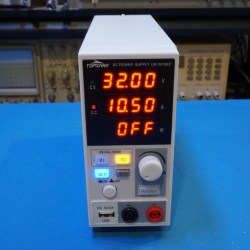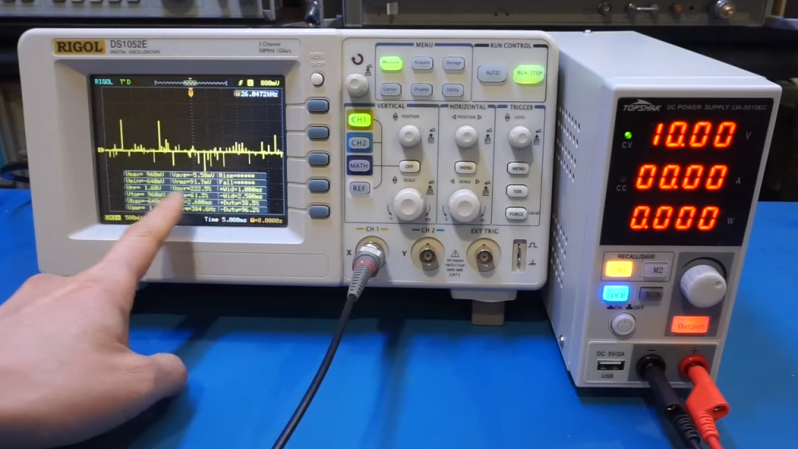[Kerry Wong] isn’t afraid to get his hands dirty, and is always more than willing to open things up and see what makes them tick. This time, he reviews and tears down the Topshak LW-3010EC programmable DC power supply, first putting the unit through its paces, then opens it up to see how it looks on the inside.
 The Topshak LW-3010EC is in a family of reasonably economical power supplies made by a wide variety of manufacturers, which all share many of the same internals and basic construction. This one is both programmable as well as nice and compact, and [Kerry] compares and contrasts it with other power supplies in the same range as he tests the functions and checks over the internals.
The Topshak LW-3010EC is in a family of reasonably economical power supplies made by a wide variety of manufacturers, which all share many of the same internals and basic construction. This one is both programmable as well as nice and compact, and [Kerry] compares and contrasts it with other power supplies in the same range as he tests the functions and checks over the internals.
Overall, [Kerry] seems pleased with the unit. You can watch him put the device through its paces in the video embedded below, which ends with him opening it up and explaining what’s inside. If you’ve ever been curious about what’s inside one of these power supplies and how they can be expected to perform, be sure to fire up the video below the page break.
Speaking of power supplies, most of us have ready access to ATX power supplies. They are awfully capable pieces of hardware, and hackable in their own way. Our own Jenny List will tell you everything you need to know about the ATX power supply, and how to put it to new uses.
















The maximum of “200mA” measured is wrong. First 2V / 100 Ohm is about 20mA not 200mA.
Second the 2V is wrong: His scope clipped the signal at the edge of the screen, so AFTER capture, you cannot bring stuff that is vertically out of the screen back in view. You’ll always get this clipped view.
Well unfortunately we dont get to see how it’s programmable as the windows software triggered a virus alert for him.
But in the comments there is a mention of a website called Virus Total which was great to learn about, as you can upload suspicious files to and it will analyze them for you.
Serendipity indeed.
anything that is not signed and tries to access a port will trigger a virus scanner, meanwhile you can rewrite your boot sector and it won’t even notice
ATX conversions are about as useful as having a box of wall warts, then you start adding stuff onto it and all of the sudden you have a large pile of junk that cost more and is starting to approach a 40$ amazon special.
Agreed, but as fixed voltage high current supplies, they can work quite well.
I modified a 450W ATX supply to provide 13.8V at 30+A to power a commercial 52MHz FM mobile transceiver and it worked very well. It was, I will admit, a LOT of reverse engineering and modification, almost all of it related to bodging the existing transformer windings into something that could give me ~12V at 30A. But the learning experience was well worth it and I was even able to retain the OV and OC capability.
And, if you’ve ever priced out a 13.8V/30A regulated bench supply, you’ll agree that a weekend’s worth of reverse engineering and hacking was worth the effort.
I do suspect that it would be possible to convert an ATX supply to a 0-30V/0-20A bench supply, with foldback current limiting, but it might involve rewinding the transformer. Still, I’d like to see it done right (i.e.without requiring a 5V load resistor)..maybe when I retire.
I didn’t watch the whole video in depth, but his measurements he makes with the scope are using alligator wires hooked to a probe scope, or at least the ground lead was. Unfortunately, you can’t expect any kind of accurate measurements at higher frequencies, the range at which ripple would be measured in. you have to use a ground spring or other such mechanism to reduce the loop inductance to as close as zero as possible over the load, otherwise those measurements don’t mean anything as you’re literally making a loop antenna with the cables and it can pick up who knows what type of radiated signals. With proper measurements, i could easy see the noise be attenuated by 50+ mv or more.
Thanks bringing that up. Anyone that has cornered low level fast noise gremlins went ouch on his setup.
There sure are a lot of 30V/3A-type programmable bench supplies out there now. I sure wish somebody would do a modern >=100V (250 ideally) supply; half an amp or something like that. The affordable aftermarket offerings are pretty thin on the ground (and generally only GPIB-able). Anyone have a useful pointer to such a thing?
50 VDC and above requires licensing to use. That’s why you can’t find them on the market. 48 VDC is the max you can buy off the shelf as a regular consumer.
“50 VDC and above requires licensing to use.” Really? And in what Labor Union-Controlled Nanny-State do you live in?
Right
A RD6006 and a scrounged DC supply.
There, I said it :)
Oops, meant to put that in the main thread and I can’t move it :(
@18:55 “As I don’t see any discrete DAC”. So what do all those shift registers do with 16 resistors each? Looks like an R2R DAC to me.
@19:32 U8 labeled with “RS485” is an LM358?
@14:30 The trace was clipped by the oscilloscope, he knows it, and then still continues to say that the power supply delivered 200mA instead of the 100mA of the current limit?
@14:17 700ms before the Over current function kicks in is quite atrocious. Proably has something to do with the relay. For a power supply I would much prefer to have the output under software control instead of a relay that bounces. But it’s a high power / current power supply and not a “precision” power supply, so it may be forgivable.
@07:20 “By default the Over Current Protection is off”. This function turns off the output completely when a fault is dected. Does it work in a normal Constant Current mode when this function is “off”?